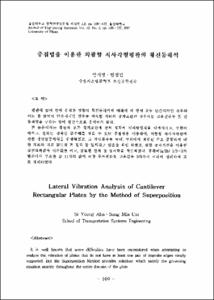초경합금의 미세조직인자에 따른 경도와 인성에 관한 연구
- Alternative Title
- A Study on the Hardness and Toughness of Cemented Carbides as a function of Microstructural Parameters
- Abstract
- 본 연구에서는 초경합금의 변형기구를 이해하기 위하여 초경합금의 미세조직 인자에 따른 경도와 인성을 조사하였다. 특히 초경합금의 인성을 측정하기 위해 항절력시험, 충격시험, Palmqvist시험, 평면변형파괴 인성시험을 수행한 결과 다음과 같은 결론을 얻었다.
1) 초경합금의 비커스 경도와 미세조직인자와 관계는 Hall-Petch관계식이 성립하며 Hall-Petch상수 H?와 K₁는 각각 425Kg/mm², 559Kg/mm³?²로 주어지며 초경합금의 강도지배인자는 True MFP임을 확인하였다.
2) 항절력시험 결과 항절력은 True MFP가 0.62μm 일때 최대값을 갖는다.
3) 초경합금의 충격강도는 주로 초경합금의 취약한 상의 양에 의존되며 충격강도는 Cobalt함량이 증가함에 따라 증가하나 초경합금의 입도에 따른 영향은 거의 없다.
4) Palmqvist시험으로 얻어진 결과는 10?/W=AH-B이며 여기서 W는 균열저항계수, H는 Vickers경도이며 상수 A, B는 각각 0.0216, 20.93이었다. 이 관계식은 초경합금의 연구와 품질관리에 유용한 식이 될 수 있다.
5) 방전가공기에 의해 Notch를 부여한 SENB시편을 3점 굽힘시험에 의해 K?값을 측정한 결과 평면변형파괴인성은 미세조직인자 중 True MFP와 WC입자의 분산정도에 의존되며 초경합금의 경도 증가에 따라 직선적으로 감소한다. 선형탄성파괴역학에 근거로부터 계산된 임계변형에너지 해방율, G?는 True MFP의 증가와 더불어 직선적으로 증가한다.
In the present investigation, to understand the deformation mechanism of cemented tungsten carbides, the variation of the hardness and toughness of cemented tungsten carbide was studied as a function of its microstructural parameters. Particularly, in order to evaluate the toughness of cemented tungsten carbides, transverse rupture test, impact test, Palmqvist test, plane strain fracture toughness test were used.
Results obtained are as follows.
1) The relation of the Vickers indentation hardness of cemented carbide to its microstructural parameters can be presented by the Hall-Petch type equation. The value of Hall-Petch constant H? and K? are give as 425Kg/mm? and 559Kg/mm?, respectively. The true MFP of cobalt layers is proposed as the strength controlling microstructural parameter.
2) In transverse rupture test, it has been shown that TRS reaches a maximum for the critical value of true MFP (0.62μm).
3) Impact strength is a function, mainly, of the amount of the brittle phase present in the WC-CO alloys. It continues to increase with the percentage of cobalt, but the effect of grain size is relatively small.
4) It is shown experimentally that the parameters measured by the Palmqvist test crack resistance parameter, W and the hardness, H, are related by the following expression 10?/W=AH-B. The values of constant A and B are given as 0.0216 and 20.93, respectively. This method is very useful for daily measurement of toughness, for example in studying materials and in quality control of products.
5) The fracture toughness values (K?) of cemented carbides depends on the microstructural parameter, particularly the true MFP of cobalt binder and degree of separation of WC grains. The fracture toughness decreases almost linearly with the hardness of cemented carbides. The critical strain energy release rate, G? calculated from the linear elastic fracture mechanics relationships also increases linearly with the true MFP.
In the present investigation, to understand the deformation mechanism of cemented tungsten carbides, the variation of the hardness and toughness of cemented tungsten carbide was studied as a function of its microstructural parameters. Particularly, in order to evaluate the toughness of cemented tungsten carbides, transverse rupture test, impact test, Palmqvist test, plane strain fracture toughness test were used.
Results obtained are as follows.
1) The relation of the Vickers indentation hardness of cemented carbide to its microstructural parameters can be presented by the Hall-Petch type equation. The value of Hall-Petch constant H? and K? are give as 425Kg/mm? and 559Kg/mm?, respectively. The true MFP of cobalt layers is proposed as the strength controlling microstructural parameter.
2) In transverse rupture test, it has been shown that TRS reaches a maximum for the critical value of true MFP (0.62μm).
3) Impact strength is a function, mainly, of the amount of the brittle phase present in the WC-CO alloys. It continues to increase with the percentage of cobalt, but the effect of grain size is relatively small.
4) It is shown experimentally that the parameters measured by the Palmqvist test crack resistance parameter, W and the hardness, H, are related by the following expression 10?/W=AH-B. The values of constant A and B are given as 0.0216 and 20.93, respectively. This method is very useful for daily measurement of toughness, for example in studying materials and in quality control of products.
5) The fracture toughness values (K?) of cemented carbides depends on the microstructural parameter, particularly the true MFP of cobalt binder and degree of separation of WC grains. The fracture toughness decreases almost linearly with the hardness of cemented carbides. The critical strain energy release rate, G? calculated from the linear elastic fracture mechanics relationships also increases linearly with the true MFP.
- Issued Date
- 1982
- Type
- Research Laboratory
- Alternative Author(s)
- Chung,Eun
- Publisher
- 연구논문집
- Language
- kor
- Rights
- 울산대학교 저작물은 저작권에 의해 보호받습니다.
- Citation Volume
- 13
- Citation Number
- 2
- Citation Start Page
- 391
- Citation End Page
- 407
- Appears in Collections:
- Research Laboratory > University of Ulsan Report
- 파일 목록
-
-
Download
 000002024808.pdf
기타 데이터 / 1.02 MB / Adobe PDF
000002024808.pdf
기타 데이터 / 1.02 MB / Adobe PDF
-
Items in Repository are protected by copyright, with all rights reserved, unless otherwise indicated.